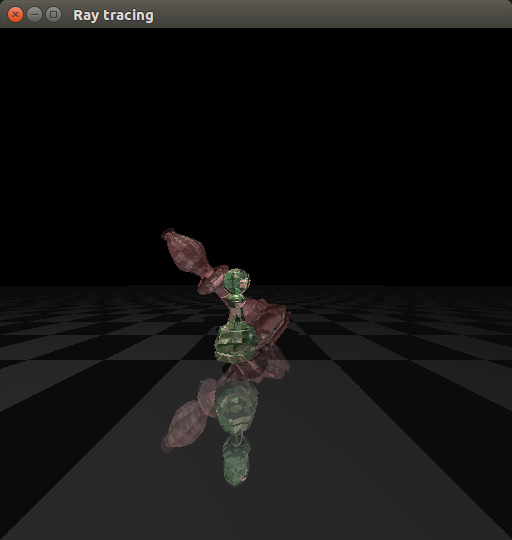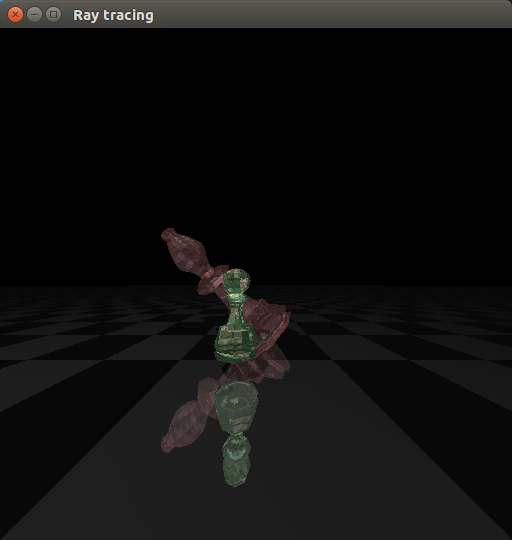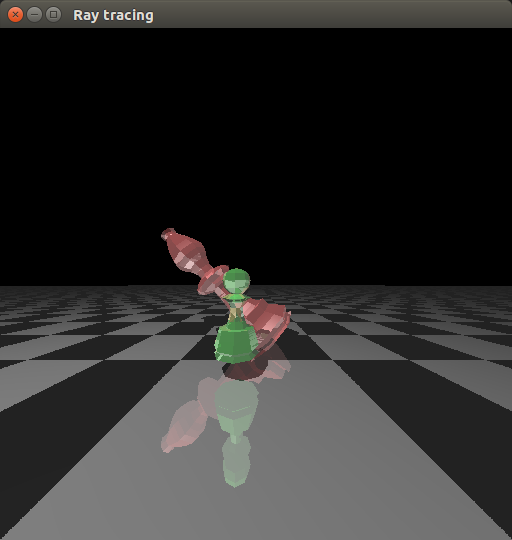This is a bonus part of homework assignment of CMPT361/SFU
- SMF reader
- parallel ray tracing via multiple thread
- bounding volume hierarchy with AABB(Axis-Aligned minimum bounding box)
make
./raycast step_max <options>- step_max: max depth of ray tracing
- options:
- +p: turn on parallel ray tracing
- +b: turn on bounding volume hierarchy
bowenc@bowenc-MS-7A59:~/cmpt361/glass-chess$ ./raycast 6 +b +p
Num of intersection: 3924721
Ray Trace done in 0.151097 sbowenc@bowenc-MS-7A59:~/cmpt361/glass-chess$ ./raycast 6 +p
Num of intersection: 641162400
Ray Trace done in 5.058907 sbowenc@bowenc-MS-7A59:~/cmpt361/glass-chess$ ./raycast 1 +b
Num of intersection: 676182
Ray Trace done in 0.133134 sTo see the efficiency of bounding volume and parallel tracing
| trace depth | bbh | parallel | Intersection | Time(s) |
|---|---|---|---|---|
| 1 | on | off | 676182 | 0.165687s |
| 1 | off | on | 432298400 | 3.131259s |
| 1 | off | off | 432298400 | 11.594307s |
| 1 | on | on | 676182 | 0.047875s |
| 4 | on | off | 2788389 | 0.338186s |
| 4 | off | on | 546695200 | 4.124525s |
| 4 | off | off | 546695200 | 14.655227 |
| 4 | on | on | 2788389 | 0.118568s |
It turns out that the origin skeleton code is messed up with global and extern variable. It would be more elegant if we reorganized everything into class and treat tracer, triangle, plane and others as object.
The main idea of it is to assign different region of image for each tracer, and let tracers do ray tracing in thread independently, where each tracer only casts ray through pixels inside its assigned region. The idea to wrap tracer suff into a class is really beneficial here.
The basic idead of BVH is to split the space recursively and wrap the objects into a bounding box. When it comes to intersection, we can intersect with bounding box first and then triangles inside.
The general procedure are:
- Bvh Tree construction
- start with root node, which contains all the objects
- wrap all the vertexes of object into a bbox(bounding box), set it as the box of node
- wrap all the centroid of object into another bbox
- find the axis with largest length
- divide the bbox into two part, and split the objects inside accordingly
- then have left node and right node
- do the same thing on left node and right node recursively
- when finished, we have a tree, which each node has a list of objects which wrapped by a bbox
- start with root node, which contains all the objects
- Bvh Intersection
- given eye, ray
- travere the tree, do the intersection on nodes
- if intersects, do the intersection on its children
- if intersect leaves, do the intersection on the objects wrapped inside
When deal with glm, it's better to declare value ends in *.*f, otherwise there could be error like
note: ‘glm::vec3 {aka glm::tvec3<float, (glm::precision)0u>}’ is not derived from ‘const glm::tmat4x4<T, P>’

